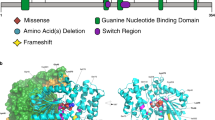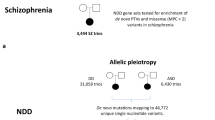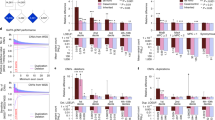Abstract
There are thousands of rare human disorders that are caused by single deleterious, protein-coding genetic variants1. However, patients with the same genetic defect can have different clinical presentations2,3,4, and some individuals who carry known disease-causing variants can appear unaffected5. Here, to understand what explains these differences, we study a cohort of 6,987 children assessed by clinical geneticists to have severe neurodevelopmental disorders such as global developmental delay and autism, often in combination with abnormalities of other organ systems. Although the genetic causes of these neurodevelopmental disorders are expected to be almost entirely monogenic, we show that 7.7% of variance in risk is attributable to inherited common genetic variation. We replicated this genome-wide common variant burden by showing, in an independent sample of 728 trios (comprising a child plus both parents) from the same cohort, that this burden is over-transmitted from parents to children with neurodevelopmental disorders. Our common-variant signal is significantly positively correlated with genetic predisposition to lower educational attainment, decreased intelligence and risk of schizophrenia. We found that common-variant risk was not significantly different between individuals with and without a known protein-coding diagnostic variant, which suggests that common-variant risk affects patients both with and without a monogenic diagnosis. In addition, previously published common-variant scores for autism, height, birth weight and intracranial volume were all correlated with these traits within our cohort, which suggests that phenotypic expression in individuals with monogenic disorders is affected by the same variants as in the general population. Our results demonstrate that common genetic variation affects both overall risk and clinical presentation in neurodevelopmental disorders that are typically considered to be monogenic.
This is a preview of subscription content, access via your institution
Access options
Access Nature and 54 other Nature Portfolio journals
Get Nature+, our best-value online-access subscription
$29.99 / 30 days
cancel any time
Subscribe to this journal
Receive 51 print issues and online access
$199.00 per year
only $3.90 per issue
Buy this article
- Purchase on Springer Link
- Instant access to full article PDF
Prices may be subject to local taxes which are calculated during checkout



Similar content being viewed by others
Data availability
The raw genotype data, post-quality-control genotype data and discovery GWAS summary statistics generated and/or analysed during the current study are available through European Genome-phenome Archive, under EGAS00001000775. This study makes use of data generated by the DECIPHER community: a full list of centres that contributed to the generation of the data is available from http://decipher.sanger.ac.uk, and via email from decipher@sanger.ac.uk. Information on how to access the data from the UKHLS can be found on the ‘Understanding Society’ website, at https://www.understandingsociety.ac.uk/.
References
Boycott, K. M. et al. International cooperation to enable the diagnosis of all rare genetic diseases. Am. J. Hum. Genet. 100, 695–705 (2017).
Owen, C. I. et al. Extending the phenotype associated with the CSNK2A1-related Okur–Chung syndrome—a clinical study of 11 individuals. Am. J. Med. Genet. A 176, 1108–1114 (2018).
Singh, T. et al. Rare loss-of-function variants in SETD1A are associated with schizophrenia and developmental disorders. Nat. Neurosci. 19, 571–577 (2016).
Balasubramanian, M. et al. Delineating the phenotypic spectrum of Bainbridge-Ropers syndrome: 12 new patients with de novo, heterozygous, loss-of-function mutations in ASXL3 and review of published literature. J. Med. Genet. 54, 537–543 (2017).
Minikel, E. V. et al. Quantifying prion disease penetrance using large population control cohorts. Sci. Transl. Med. 8, 322ra9 (2016).
Wright, C. F. et al. Genetic diagnosis of developmental disorders in the DDD study: a scalable analysis of genome-wide research data. Lancet 385, 1305–1314 (2015).
The Deciphering Developmental Disorders Study. Large-scale discovery of novel genetic causes of developmental disorders. Nature 519, 223–228 (2015).
Bulik-Sullivan, B. K. et al. LD score regression distinguishes confounding from polygenicity in genome-wide association studies. Nat. Genet. 47, 291–295 (2015).
Grove, J. et al. Common risk variants identified in autism spectrum disorder. Preprint at https://www.doi.org/10.1101/224774 (2017).
Wray, N. R. et al. Genome-wide association analyses identify 44 risk variants and refine the genetic architecture of major depression. Nat. Genet. 50, 668–681 (2018).
Weiner, D. J. et al. Polygenic transmission disequilibrium confirms that common and rare variation act additively to create risk for autism spectrum disorders. Nat. Genet. 49, 978–985 (2017).
The International Schizophrenia Consortium. Common polygenic variation contributes to risk of schizophrenia and bipolar disorder. Nature 460, 748–752 (2009).
The Brainstorm Consortium. Analysis of shared heritability in common disorders of the brain. Science 360, eaap8757 (2018).
Bulik-Sullivan, B. et al. An atlas of genetic correlations across human diseases and traits. Nat. Genet. 47, 1236–1241 (2015).
Lee, J.J. et al. Gene discovery and polygenic prediction from a genome-wide association study of educational attainment in 1.1 million individuals. Nat. Genet. 50, 1112–1121 (2018).
Sniekers, S. et al. Genome-wide association meta-analysis of 78,308 individuals identifies new loci and genes influencing human intelligence. Nat. Genet. 49, 1107–1112 (2017).
Finucane, H. K. et al. Partitioning heritability by functional annotation using genome-wide association summary statistics. Nat. Genet. 47, 1228–1235 (2015).
Lindblad-Toh, K. et al. A high-resolution map of human evolutionary constraint using 29 mammals. Nature 478, 476–482 (2011).
The Deciphering Developmental Disorders Study. Prevalence and architecture of de novo mutations in developmental disorders. Nature 542, 433–438 (2017).
Martin, H. C. et al. Quantifying the contribution of recessive coding variation to developmental disorders. Preprint available at https://www.doi.org/10.1101/201533 (2017).
Firth, H. V. et al. DECIPHER: database of chromosomal imbalance and phenotype in humans using Ensembl resources. Am. J. Hum. Genet. 84, 524–533 (2009).
Reichenberg, A. et al. Discontinuity in the genetic and environmental causes of the intellectual disability spectrum. Proc. Natl Acad. Sci. USA 113, 1098–1103 (2016).
Flannick, J., Johansson, S. & Njølstad, P. R. Common and rare forms of diabetes mellitus: towards a continuum of diabetes subtypes. Nat. Rev. Endocrinol. 12, 394–406 (2016).
Hernandez, D. G., Reed, X. & Singleton, A. B. Genetics in Parkinson disease: Mendelian versus non-Mendelian inheritance. J. Neurochem. 139, 59–74 (2016).
Ganna, A. et al. Ultra-rare disruptive and damaging mutations influence educational attainment in the general population. Nat. Neurosci. 19, 1563–1565 (2016).
Tansey, K. E. et al. Common alleles contribute to schizophrenia in CNV carriers. Mol. Psychiatry 21, 1085–1089 (2016).
Kuchenbaecker, K. B. et al. Evaluation of polygenic risk scores for breast and ovarian cancer risk prediction in BRCA1 and BRCA2 mutation carriers. J. Natl Cancer Inst. 109, djw302 (2017).
Martinelli, S. et al. Functional dysregulation of CDC42 causes diverse developmental phenotypes. Am. J. Hum. Genet. 102, 309–329 (2018).
Khanna, H. et al. A common allele in RPGRIP1L is a modifier of retinal degeneration in ciliopathies. Nat. Genet. 41, 739–745 (2009).
Short, P. J. et al. De novo mutations in regulatory elements in neurodevelopmental disorders. Nature 555, 611–616 (2018).
University of Essex Institute for Social and Economic Research, NatCen Social Research & Kantar Public. Understanding Society: Waves 1–7, 2009–2016 and Harmonised BHPS: Waves 1–18, 1991–2009 10th edn (UK Data Service, 2018).
University of Essex Institute for Social and Economic Research. Understanding Society: Waves 2 and 3 Nurse Health Assessment, 2010–2012 3rd edn (UK Data Service, 2014).
Wright, M. J. & Martin, N. G. Brisbane adolescent twin study: outline of study methods and research projects. Aust. J. Psychol. 56, 65–78 (2004).
Mina-Vargas, A. et al. Heritability and GWAS analyses of acne in Australian adolescent twins. Twin Res. Hum. Genet. 20, 541–549 (2017).
The Haplotype Reference Consortium. A reference panel of 64,976 haplotypes for genotype imputation. Nat. Genet. 48, 1279–1283 (2016).
Loh, P.-R. et al. Reference-based phasing using the Haplotype Reference Consortium panel. Nat. Genet. 48, 1443–1448 (2016).
Durbin, R. Efficient haplotype matching and storage using the positional Burrows–Wheeler transform (PBWT). Bioinformatics 30, 1266–1272 (2014).
Loh, P.-R. et al. Efficient Bayesian mixed-model analysis increases association power in large cohorts. Nat. Genet. 47, 284–290 (2015).
Zheng, J. et al. LD Hub: a centralized database and web interface to perform LD score regression that maximizes the potential of summary level GWAS data for SNP heritability and genetic correlation analysis. Bioinformatics 33, 272–279 (2017).
Pardiñas, A. F. et al. Common schizophrenia alleles are enriched in mutation-intolerant genes and in regions under strong background selection. Nat. Genet. 50, 381–389 (2018).
Adams, H. H. H. et al. Novel genetic loci underlying human intracranial volume identified through genome-wide association. Nat. Neurosci. 19, 1569–1582 (2016).
Wood, A. R. et al. Defining the role of common variation in the genomic and biological architecture of adult human height. Nat. Genet. 46, 1173–1186 (2014).
Horikoshi, M. et al. Genome-wide associations for birth weight and correlations with adult disease. Nature 538, 248–252 (2016).
Okbay, A. et al. Genome-wide association study identifies 74 loci associated with educational attainment. Nature 533, 539–542 (2016).
Palla, L. & Dudbridge, F. A fast method that uses polygenic scores to estimate the variance explained by genome-wide marker panels and the proportion of variants affecting a trait. Am. J. Hum. Genet. 97, 250–259 (2015).
Wright, C. F. et al. Making new genetic diagnoses with old data: iterative reanalysis and reporting from genome-wide data in 1,133 families with developmental disorders. Genet. Med. https://doi.org/10.1038/gim.2017.246 (2018).
Acknowledgements
We thank the families involved in the DDD study for their participation and patience, the DDD study clinicians, research nurses and clinical scientists in the recruiting centres for their hard work on behalf of families, M. Niemi for help making Fig. 1 and V. Warrier for useful discussions. The DDD study presents independent research commissioned by the Health Innovation Challenge Fund (grant number HICF-1009-003), a parallel funding partnership between Wellcome and the Department of Health, and the Wellcome Sanger Institute (grant number WT098051). The views expressed in this publication are those of the author(s) and not necessarily those of Wellcome or the Department of Health. The research team acknowledges the support of the National Institute for Health Research, through the Comprehensive Clinical Research Network. This study makes use of data generated by the DECIPHER community. Funding for the project was provided by the Wellcome Trust. We used data from ‘Understanding Society: The UK Household Longitudinal Study’, which is led by the Institute for Social and Economic Research at the University of Essex and funded by the Economic and Social Research Council (grant number ES/M008592/1). The data were collected by NatCen and the genome-wide scan data were analysed by the Wellcome Trust Sanger Institute. Data governance was provided by the METADAC data access committee, funded by ESRC, Wellcome and MRC (grant number MR/N01104X/1). Australian controls from the Brisbane Longitudinal Twin Study were collected and genotyped with grants from the National Health and Medical Research Council. We thank A. Pardiñas for producing the PGC-CLOZUK summary statistics without the Australian controls.
Reviewer information
Nature thanks D. Arking, C. Lewis and S. Ripke for their contribution to the peer review of this work.
Author information
Authors and Affiliations
Contributions
J.C.B., C.F.W., D.R.F., H.V.F. and M.E.H. designed the study. M.E.K.N., H.C.M., D.L.R., G.G., M.K., J.M. and E.J.R. contributed to data analysis. S.Y., J.G. and N.G.M. performed data collection for the Australian cohort. K.M. and S.G. prepared data from the Australian cohort. M.E.K.N., H.C.M. and J.C.B. wrote the paper. H.C.M. and J.C.B. supervised the analyses and J.C.B. supervised the project.
Corresponding author
Ethics declarations
Competing interests
M.E.H. is a co-founder of, consultant to and holds shares in Congenica, a genetics diagnostic company. J.C.B. is an employee of Genomics plc.
Additional information
Publisher’s note: Springer Nature remains neutral with regard to jurisdictional claims in published maps and institutional affiliations.
Extended data figures and tables
Extended Data Fig. 1 Ancestry principal components analysis of UK and Australian samples.
a, b, Reference samples (n = 2,504) from 1000 Genomes Phase 3, coloured by the five super-populations, used for a projection PCA of UK cohorts (DDD and UKHLS) (a) or Australian cohorts (b). c, d, All DDD cases (discovery n = 11,304 and from trios n = 930) (c) and all Australian cases (n = 2,283) (d) from their respective projection PCA with 1000 Genomes. Case samples from individuals with European ancestry are plotted in red and non-Europeans in grey. e, f, All UKHLS controls (n = 10,396) (e) and all Australian controls (n = 4,274) (f) from their respective projection PCA with 1000 Genomes. Control samples from individuals with European ancestry are plotted in blue and non-Europeans in grey. All cases and controls coloured in grey (in c–f) were excluded from analysis owing to non-European ancestry. UK cohorts are plotted after removal of samples that failed quality control, and Australian cohorts before removal of samples that failed quality control.
Extended Data Fig. 2 Discovery GWAS of neurodevelopmental disorder risk.
a, Manhattan plot of discovery GWAS of neurodevelopmental disorder risk, with 6,987 DDD cases and 9,270 ancestry-matched UKHLS controls (both for individuals with European ancestry), using 4,134,438 variants, MAF ≥ 5%, chromosomes 1–22. P values were from a two-tailed χ2 distribution. Red line represents the threshold for genome-wide significance (P = 5 × 10−8). b, Quantile–quantile plot of discovery GWAS of neurodevelopmental disorder risk. Red line represents the expected values under the null hypothesis.
Extended Data Fig. 3 Ancestry principal components analysis of samples from the UK and Australian (principal components 2–5).
Reference samples (n = 2,504) from 1000 Genomes Phase 3—coloured by the five super-populations—are plotted on the left hand side, from projection PCAs with UK cohorts. Middle panels show the principal components plotted for DDD cases (discovery n = 10,556 and from trios n = 911) (UK samples) and Australian cases (n = 2,283). Red, case samples from individuals with European ancestry. Grey, samples from individuals of non-European ancestry; these individuals were excluded from analyses. Right-hand panels show principal components for UKHLS controls (n = 10,396) (UK samples) and Australian controls (n = 4,274). Blue, control samples from individuals with European ancestry. Grey, samples from individuals of non-European ancestry; these individuals were excluded from analyses. UK cohorts are plotted after removal of samples that failed quality control, and Australian cohorts before removal of samples that failed quality control.
Supplementary information
Supplementary Information
This file contains Supplementary Tables 1 and 2. Supplementary Table 1: Summary information for samples and variants genotyped on different DNA chips. This file contains summary information about all the data used in this study (UK and Australian cohorts), including genotyping chip information, and sample and variant numbers before and after quality control. Supplementary Table 2: Enrichment of neurodevelopmental disorder risk heritability in different cell type groups and overlapping functional categories. This file contains the results from the neurodevelopmental disorder risk GWAS (6,987 cases and 9,270 controls) partitioned SNP heritability analysis using LD score method.
Rights and permissions
About this article
Cite this article
Niemi, M.E.K., Martin, H.C., Rice, D.L. et al. Common genetic variants contribute to risk of rare severe neurodevelopmental disorders. Nature 562, 268–271 (2018). https://doi.org/10.1038/s41586-018-0566-4
Received:
Accepted:
Published:
Issue Date:
DOI: https://doi.org/10.1038/s41586-018-0566-4
Keywords
This article is cited by
-
Etiologic heterogeneity, pleiotropy, and polygenicity in behaviorally defined intellectual and developmental disabilities
Journal of Neurodevelopmental Disorders (2024)
-
olf413 an octopamine biogenesis pathway gene is required for axon growth and pathfinding during embryonic nervous system development in Drosophila melanogaster
BMC Research Notes (2024)
-
Genetic modifiers of rare variants in monogenic developmental disorder loci
Nature Genetics (2024)
-
Investigating the role of common cis-regulatory variants in modifying penetrance of putatively damaging, inherited variants in severe neurodevelopmental disorders
Scientific Reports (2024)
-
Pleiotropic contribution of rbfox1 to psychiatric and neurodevelopmental phenotypes in two zebrafish models
Translational Psychiatry (2024)
Comments
By submitting a comment you agree to abide by our Terms and Community Guidelines. If you find something abusive or that does not comply with our terms or guidelines please flag it as inappropriate.



